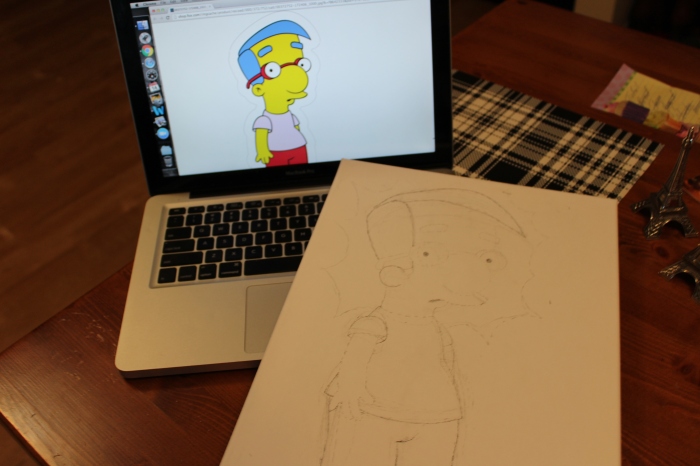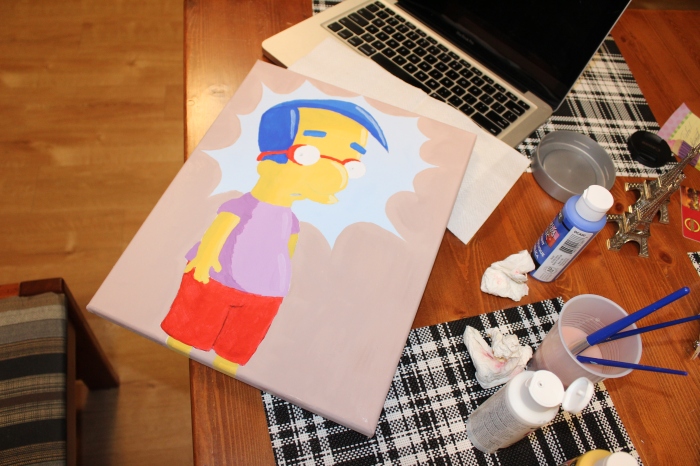Having finished my third The Simpsons painting (Milhouse Van Houten), I definitely feel as though I’ve hit my stride/found my groove in terms of style. This is where I belong: painting the Simpsons, one character at a time.
This being said, however, even the smoothest of grooves contain a few bumps here and there. The final result is perhaps one of my best (stay tuned to later in the post), however, it wasn’t easy getting there. Normally when I draw my characters, it goes pretty flawlessly. This time was different.
I, for whatever reason, struggled with Milhouse’s proportions and erased and redrew at least 10 times. Each time I erased, my new lines were harder to see so I had to press more firmly with my pencil, creating darker and darker lines. Then when I erased those lines, I had to go even darker the next time. Long story short… I made a mess.


My plan was to simply paint over the pencil lines over and over again until they went away. This would have been difficult considering the yellow I use is fairly light (I mix it with white). Luckily, I found the following video that seemed to save several layers of paint, a few hours of repainting, and the piece in general.
This site, as well as art-is-fun.com (which has become one of my go-to sites) also offered some great solutions. It was, however, much easier to watch the video on YouTube. The Internet has many articles that are super informative, but in this particular scenario, “Ain’t nobody got time for that!”
So here is my final product. You can see that this character is much more detailed compared to my previous characters. In particular, the glasses were quite complex. I also painted his entire body instead of just his head.

Lastly, I’m quite proud of his facial expression and the background that enhances the character’s mood. I’ve found that my best work comes from bringing the characters to life, and this one in particular seems to portray a sense of emotion. I consider this a victory.



Looking great Jordan! Good job for over coming the bumps along the way and still making the painting look fantastic!
LikeLiked by 1 person
This is very nice!! I love the progress that is is quite evident in your learning journey.
The young lady at this address http://nottinghamtrent.academia.edu/JemmaGilboy is someone I knew as a very young girl. She is “renowned for having a Simpsons analogy for everything”.
Here is her doctoral thesis topic that centers on the entire 23 seasons of the Simpsons:
Jemma Gilboy
Craptacular Science and the Collapse of a Rejected Universe: Absurdist Existentialism and Memetic Proliferation in American Animation
This thesis provides a comparative examination of Existentialist and Absurd themes present in the high-budget, digitally produced American television sitcom The Simpsons and in the low-budget, traditionally produced work of independent animator Don Hertzfeldt. These aspects will be examined through a framework of meme theory, with a focus on audience interaction and the bi-directional flow of information and ideas between audience and producer.
The methods applied to this work include the analysis of the primary texts (the entire Simpsons omnibus from Season 1 to Season 23, the entirety of Hertzfeldt’s oeuvre and interviews with Hertzfeldt and at least one Simpsons representative), critical analysis of a number of secondary texts including those defining meme theory (framework), cultural theory (audience analysis and reporting, and examination of the role of the medium), Existentialism and the Absurd (the origins and significance of the philosophical movements as they relate to the works under examination, as well as the implementation of Absurdist themes in performance), and intertextuality and parody. The arguments with respect to The Simpsons in the thesis will also be supported by a plethora of existing academic work on the series, but given the application of the memetic framework, these arguments will contribute to the existing discourse from a novel and unique perspective. Given also that no academic work on Don Hertzfeldt’s films has been detected, this thesis will fill a significant gap in the discourse on American Animation.
The thesis is two years from completion at this stage, so the bulk of the emergent findings and implications remain to be discovered.
I cannot find the finished thesis as yet, however, she has acquired her doctorate based on this in 2016. If you want to contact her to see the paper you could find her through the above link.
Here is a published paper by her and 2 other authors, How Time Works in the Simpsons, https://hydra.hull.ac.uk/assets/hull:11743/content
Enjoy.
LikeLiked by 1 person
This. Is. Awesome! Thanks for sharing, Tanya. I will definitely look into all of these. I appreciate you picking up on my love of The Simpsons and not just my progress in terms of painting. You’re the best!
LikeLike
You are welcome. You share a mutual passion with Jenna Gilboy. Perhaps, your web of fans of The Simpson’s will broaden extensively?
LikeLike
Thanks for sharing your process. It looks really cool!
LikeLiked by 1 person
Thanks, Andrea — I’m hoping to use a time lapse sometime in the next few weeks to switch things up!
LikeLike
You should be proud of that facial expression, it’s great! I enjoyed seeing the process of your work. I never would have thought to use bleach and an eraser on a canvas; what a neat trick!
LikeLiked by 1 person
Works like a charm!
LikeLike
Looks good! I am definitely going to explore that art-is-fun website! PS I love Milhouse he is my fav!
LikeLiked by 1 person
Thanks — it’s quickly become my favourite site in terms of this learning project. Every time I want to look something up, it can be found on Art-is-fun!
And yes! I always appreciate finding another Milhouse fan. So underrated as a character.
LikeLike